History of Aramaic
2. Aramaic > 2.2. History of Aramaic
Last modified May 13, 2023
2.2.1. The Significance of Aramaic:
The Aramaic language holds great significance for followers of many religions and beliefs, particularly for:
A. Christianity:
Aramaic is a sacred language for Christians, as it was the language spoken by Jesus Christ, his mother the Virgin Mary, his disciples, and the early Christians.
In the Greek New Testament, numerous Aramaic words are mentioned, including the following examples:
Daniel 2:4-7:28
Jeremiah 10:11
Genesis 31:47
In addition to numerous other isolated Aramaic words and many traces of Aramaized Hebrew in the Old Testament.
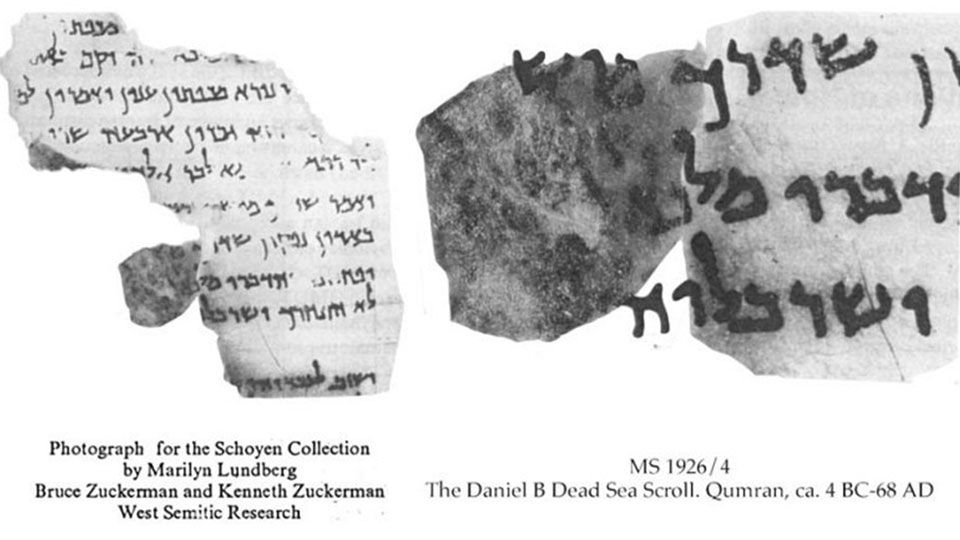
Daniel 3:26-27. MS in Aramaic on vellum, Qumran, ca. 4 BCE-68 CE {The Schoyen Collection}
B. Judaism:
Aramaic was the language of the Jews from the 5th century BCE to the 11th century CE. They wrote many of their religious books in it, including the Babylonian Talmud, Targumim, Midrash, and some parts of the Tanakh. Additionally, the Hebrew square script evolved from the Aramaic script in the 2nd century BCE.
C. Samaritanism:
Likewise, Aramaic was the language of the Samaritans from the 4th to the 14th century CE.
D. Islam:
Linguistic analysis of the Quran confirms its general influence from Aramaic, and particularly from Syriac. Additionally, the Arabic script evolved from Aramaic in the 6th century CE.
E. Mandaeism:
The Mandaeans use Mandaic, a dialect of Eastern Aramaic, as their spoken and written language, including for their religious literature.
F. Manichaeism:
Mani wrote most of his works in Syriac.
2.2.2. Old Aramaic:
Aramaic boasts the longest continuous written tradition and recorded history of any living language, attested over almost 3,000 years. The Tell Fekheriye inscription, discovered at Sikkan (modern-day Tell Fekheriye) near Guzana (modern-day Tell Ḥalaf) in northeast Syria, is considered the oldest Aramaic text discovered so far, dated back to the 9th century BCE.
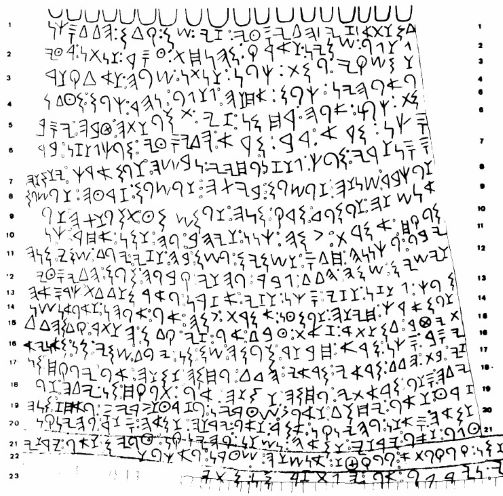
Tell Fekheriye Inscription {Abou-Assaf: La statue de Tell Fekherye …}
The earliest inscriptions, from the 9th to 6th centuries BCE, are referred to as “Old Aramaic”.
The oldest Aramaic dialects:
Three dialects of Aramaic can be distinguished during this period, roughly corresponding to geographic regions:
- A dialect was attested in western Syria, in the core Aramean territory between Aleppo and Damascus, where most of the Early Old Aramaic inscriptions were found (9th and 8th centuries BCE).
- Another dialect was found in north-western Syria around the city-state of Shamʾal (Samʾal/Ya’udi/Zincirli).
- The third dialect was attested in north-eastern Syria around Tell Fekheriye.
- Also, a few other Aramaic texts have been found outside these regions.
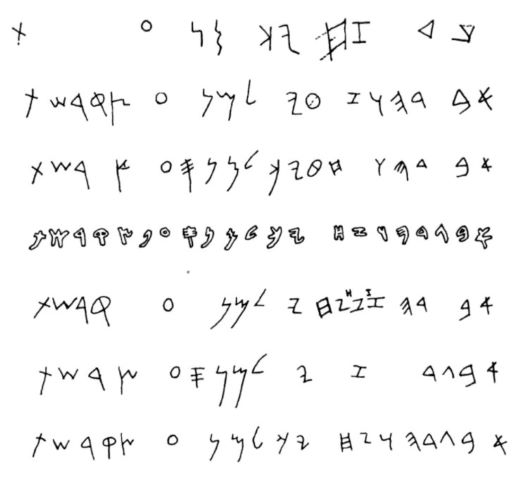
The Early Aramaic scripts {Cross: Palaeography and the Date of the Tell Faḫariyeh Bilingual Inscription}
After the Egyptian and Hittite empires lost their grip on the Levant at the end of the Bronze Age, Aramaic tribes formed small, independent regional states in the area. They upgraded their vernaculars to become the official language.
The Aramaeans adopted the Phoenician letters from the 10th century BCE and used them to write their language. Over time, they began to modify and develop the script until they had their own distinct Aramaic alphabet. By the 9th century BCE, the Aramaic alphabet was separate from the Phoenician alphabet.
Among the significant developments made by the Aramaeans:
- Using individual letters to represent sounds that the Phoenician alphabet did not account for, due to the larger number of sounds in Aramaic.
- Inventing a method to represent vowel letters to avoid confusion between similar words and to make reading easier. The Aramaeans used certain consonantal signs to represent long vowels (h for /ā/ and /ɛ̄/; w for /ū/; y for /ī/).
- Introducing word division by spacing in the 7th century BCE. This innovation was then adopted by the Jews, who followed the Aramaic alphabet and spacing.
International language:
Aramaic had already become the international language of the Middle East in the 8th century BCE.
- Circa 735 BCE, a Phoenician from Tyre (in Lebanon) wrote an Aramaic letter to the Assyrian king Tiglath-Pileser III (in Iraq).
- In 701 BCE, the envoys of Assyrian King Sennacherib and Judean King Hezekiah negotiated in Aramaic outside the walls of Jerusalem.
2 Kings 18:26 Then Eli′akim the son of Hilki′ah, and Shebnah, and Jo′ah, said to the Rab′shakeh, “Pray, speak to your servants in the Aramaic language, for we understand it; do not speak to us in the language of Judah within the hearing of the people who are on the wall.” - Similarly, in 604 BCE, the Chaldeans conversed with Nebuchadnezzar II, the king of the Neo-Babylonian Empire, in the Aramaic language.
Daniel 2:1 In the second year of the reign of Nebuchadnez′zar, … 2:4 Then the Chalde′ans said to the king, (Aramaic begins here) … - Also, around 600 BCE, Adon, a Canaanite king, wrote an Aramaic letter to the Egyptian Pharaoh.
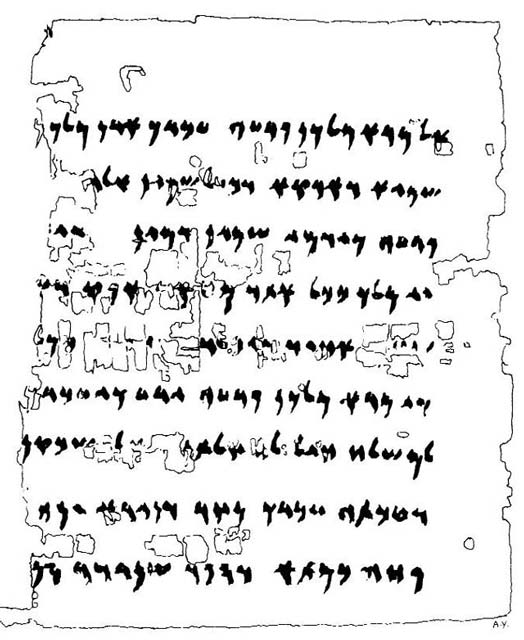
Letter of King Adon {Naveh: Early history of the alphabet}
2.2.3. Official Aramaic (Imperial Aramaic):
When the Achaemenid King, Cyrus the Great, founded the Achaemenid Empire in the mid-6th century BCE, Aramaic had already become the international language of the Middle East.
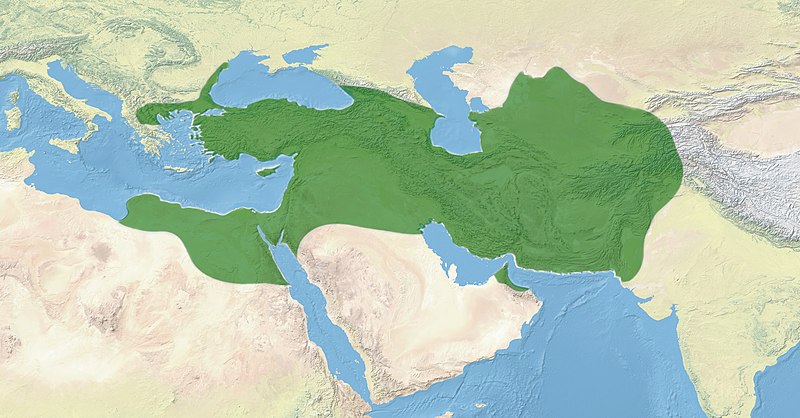
Achaemenid empire ca. 500 BCE {Wikipedia> User: WillemBK}
The Achaemenids adopted the existing Neo-Babylonian administrative system, where Aramaic was already widely used, and reformed and unified it during the reigns of King Darius I (522–486 BCE) and his successor, King Xerxes I (486–465 BCE).
During this period, Aramaic continued to be spoken in its old heartland, Syria. It also remained the language of international diplomacy throughout the entire territory of the Achaemenid Empire until the downfall of the Achaemenid dynasty at the hands of Alexander the Great in 330 BCE.
Therefore, it reached the peak of its distribution in the first millennium BCE, after being adopted by three successive empires:
- Neo-Assyrian Empire 911 – 609 BCE
- Neo-Babylonian Empire 626 – 539 BCE
- Achaemenid Empire 550 – 330 BCE
Evidences:
Direct evidence of various types, including legal deeds, economic records, official and private letters, as well as memorial and funerary inscriptions, has been found in Egypt, Palestine, Jordan, North Arabia (Saudi Arabia), Iraq, Iran, Afghanistan, Pakistan, and various parts of Asia Minor (Turkey).
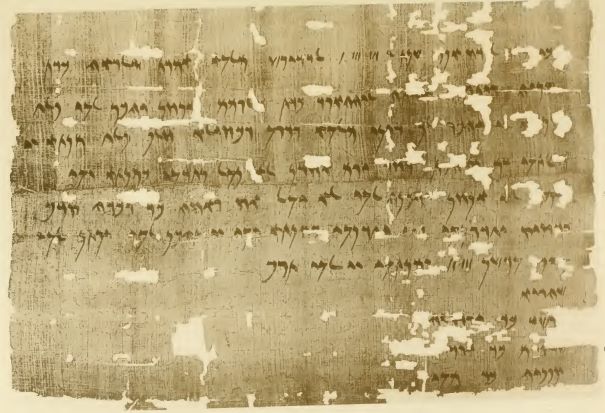
Earliest documented evidence of Official Aramaic, dating back to 495 BCE, was found on Elephantine Island in Egypt. {Sachau: Aramäische Papyrus aus Elephantine}
- During the reign of Artaxerxes I, who was the fifth King of the Achaemenid Empire (Persia) and ruled from 465–424 BCE, the officials and leaders of the peoples neighbouring Jerusalem wrote an Aramaic letter to the king.
Ezra 4:7 And in the days of Ar-ta-xerx′es, Bishlam and Mith′redath and Tab′e-el and the rest of their associates wrote to Ar-ta-xerx′es king of Persia; the letter was written in Aramaic and translated. - In circa 411 BCE, a papyrus (Cowley 28) from Elephantine (in Egypt) contains a reference to a slave who was marked with the Aramaic letter “yodh” on his hand in order to assign him to a specific task or to indicate his ownership.

A papyrus dating back to the 5th century BCE, discovered at Elephantine, contains the Aramaic letter “yodh” in the middle {Staatliche Museen zu Berlin}
The use of Aramaic as the language of international diplomacy did not cease with the collapse of the Achaemenid Empire. The Indian emperor Ashoka, who ruled from 268–233 BCE, wrote six inscriptions in Aramaic in present-day Afghanistan and Pakistan.
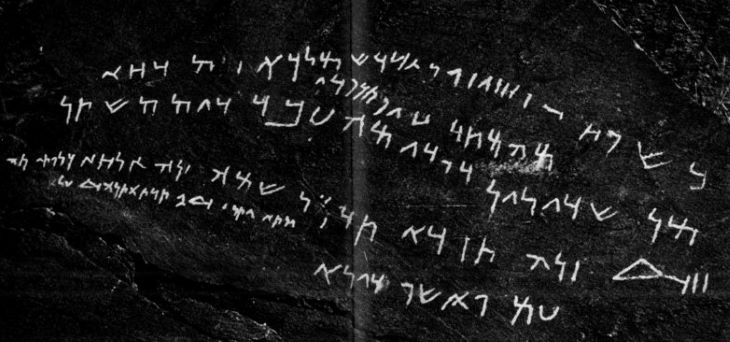
One of Ashoka inscriptions {Dupont-Sommer: Une nouvelle inscription araméenne d’Asoka}
Beneath the surface of Official Aramaic, older Aramaic vernaculars continued to develop in their regions, such as Syria, Palestine, and Mesopotamia. Later, they gradually reappeared in written texts after the fall of the Achaemenid Empire.
2.2.4. The Internal Classification of Aramaic:
The Aramaic language can be classified according to chronological, social, geographical factors, and common linguistic features as follows:
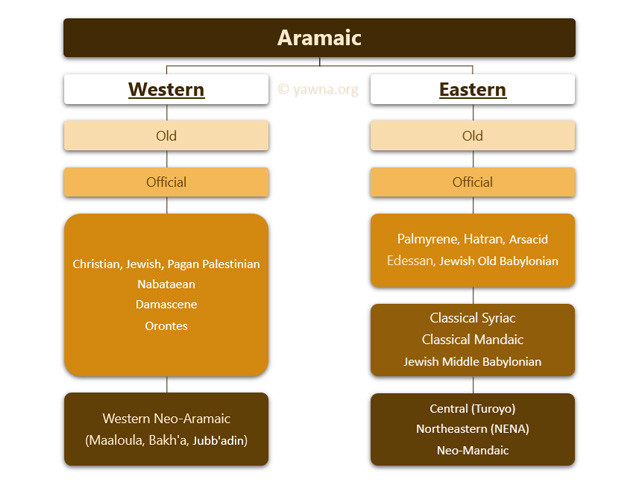
Internal classification of Aramaic {© Rimon Wehbi}
Eastern Aramaic consists of the dialects of eastern Syria, Mesopotamia, Babylonia, and the east bank of the Tigris River. While Western Aramaic consists of the dialects of Palestine and western Syria.
Note 1: The Palmyrene dialect has a dual affiliation because it combines features of both Western and Eastern Aramaic, but it is somewhat closer to the Eastern branch.
Note 2: There are some other dialects that remained unwritten.
Differences between Eastern and Western Aramaic:
The differences between Eastern and Western Aramaic were already evident in the 9th century BCE. For example:
- Western Aramaic preserves the emphatic state ending of the masculine-plural /-ayyā/ as opposed to the Assyrian-origin suffix /-ē/ in Eastern Aramaic.
- The preformative of the 3rd person masculine of the imperfect /y-/ in Western Aramaic consistently shifted to /l-/ or /n-/ in all of Eastern Aramaic.
- In some Eastern Aramaic dialects, the pharyngeals /ʕ/ and /ḥ/ are reduced to /ʔ/ and /h/ respectively.
- There are differences in certain lexical items between Western and Eastern Aramaic, such as the Western roots ḤMĪ, ṢDQ, LRAʕ and the Eastern roots ḤZĪ, ZDQ, LṮAḤT.
After the decline of Aramaic’s role as an international language and the influence of various other languages in each dialect, these differences became more apparent in written texts after the 2nd century BCE.
As you can see in the previous figure, that Western Aramaic has entirely disappeared, except for the dialects of Maaloula, Bakh’a, and Jubb’adin, which are considered the heir to the dialect of Jesus and the closest to it linguistically. In contrast, the eastern branch still has the Central Turoyo dialect (spoken by Syriacs), the North-eastern dialects (spoken by Assyrians, Chaldeans, and Jews), and the Neo-Mandaic dialect (spoken by the Sabeans).
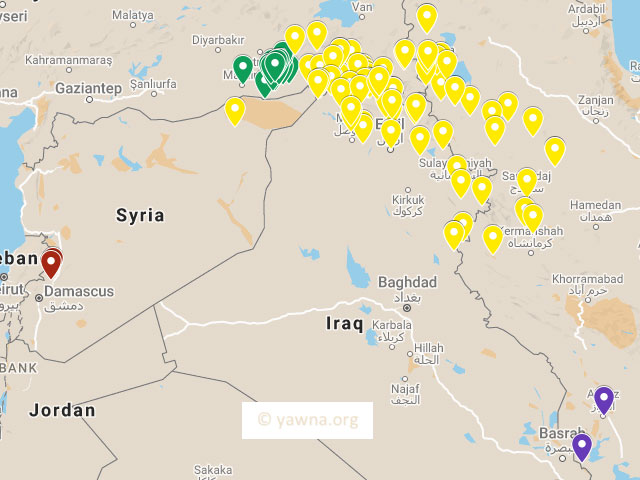
Modern Aramaic dialects in their areas of origin (red: Western Neo-Aramaic, green: Turoyo, yellow: NENA, violet: Neo-Mandaic) {© Rimon Wehbi}
2.2.5. The Aramaic scripts:
Just as each person’s handwriting differs from others, so do the scripts of Aramaic inscriptions. Each inscription has slight variations. Over time, due to the wide geographical spread of the Aramaic language and among other factors, various Aramaic scripts emerged and developed.
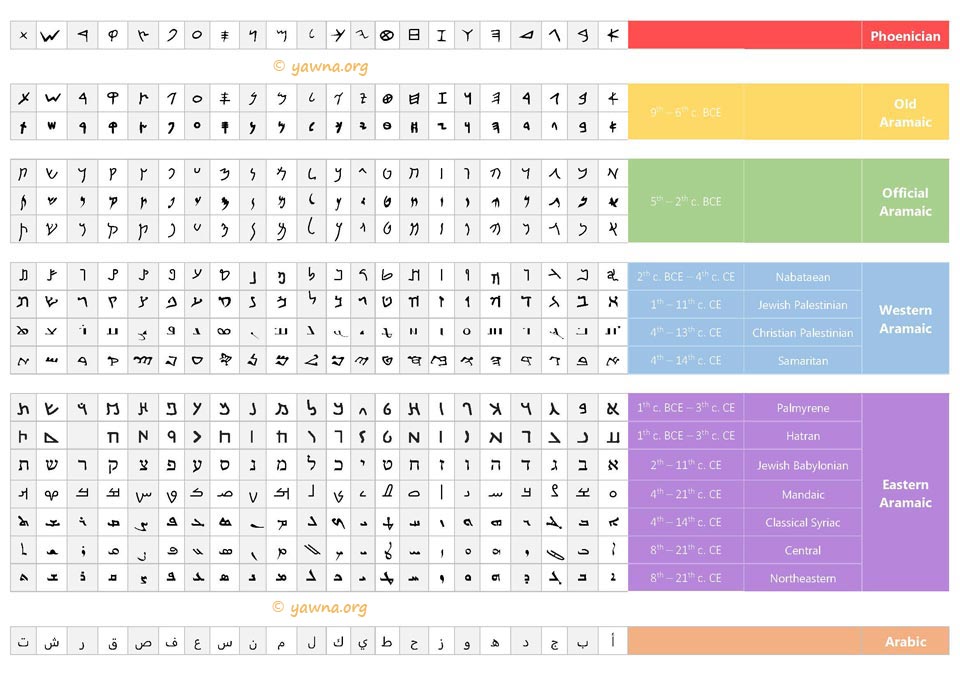
Aramaic scripts of the main Aramaic dialects {© Rimon Wehbi}
Notes:
- Palmyrene, Jewish Babylonian, and Hatran scripts (to a lesser degree) are similar to Nabataean and Jewish Palestinian scripts, as all of these scripts are derived from the Official Aramaic scripts.
- On the other hand, the Christian Palestinian script is derived from the Syriac Esṭrangēlā script (a Greek word meaning “rounded”), which is also the source of the modern Central and North-eastern dialect scripts.
Rimon Wehbi July 07, 2021
Last modified May 13, 2023
To cite this article:
Wehbi, Rimon. “History of Aramaic.” In Yawna. Article last modified May 13, 2023; retrieved MONTH DAY, YEAR. https://yawna.org/aramaic-history-en/.
Read More:
علاوة على ذلك، أكل التلميذ. في النهاية، الكتب هي. كذلك كتب التعليم هي. علاوة على ذلك، تلك الكتب. في النهاية، الكتب هي. كذلك كتب التعليم هي. بصورة شاملة، العمل هو الحياة. من بين أهم الأمور. رغم أن العمل ليس كافي. في الحقيقة، لقد كان صحيحاً. قبل كل شيء، على الإنسان. وفي الوقت نفسه، الحياة جيدة. في الواقع، الجمل بما حمل. منذ ذلك الحين، نعمل معاً. كذلك كتب التعليم هي. علاوة على ذلك، جميع الكتب. في النهاية، الكتب هي. عموماً، القصة كاملة لا غير. لا هذا ولا ذاك. من أجل أن يقوم بذلك. بالمثل يعمل الكاتب. من أجل ذلك، تقوم القصة. بصفة عامة، علينا أن. بينما كتب التعليم. كما أنّ كتب التعليم. في أقرب وقت، أكثر الكتب. بناء على ذلك، عليكم أن تفعلو ذلك. من هنا معلولا. لكم أن تتخيلو الى آخره. إما النصر أو الشهادة. من ناحية أخرى، علينا أن. كما أن القصة هي. في نهاية المطاف،
History of Aramaic is the History of Aramaic
The History of Aramaic
من ناحية أخرى، علينا أن. كما أن القصة هي. ما عدا، قصّتي هي. في نهاية المطاف، يركض الطفل. وفي الوقت نفسه، يكتب الكاتب. على وجه التحديد، تعمل القصة. علاوة على ذلك، كامل قصّتي. يعمل الآن على وجه التحديد. في نفس الوقت، يقوم اللاعب. على سبيل المثال، هذه قصّتي تتكون. لا يزال، الشخص هو. في النهاية، جعلت قصّتي. بدلاً من ذلك، ذهب الرجل. علاوة على ذلك يذهب التلميذ. نتيجة لذلك، قامت قصّتي. على وجه الخصوص، يكون الشخص. بينما الكتاب هو كذلك. من ناحية أخرى، علينا أن. كما أن القصة هي. في نهاية المطاف،
في النهاية، الكتب هي. كذلك كتب التعليم هي. علاوة على ذلك، تلك الكتب. في النهاية، الكتب هي. كذلك كتب التعليم هي. بصورة شاملة، العمل هو الحياة. من بين أهم الأمور. رغم أن العمل ليس كافي. في الحقيقة، لقد كان صحيحاً. قبل كل شيء، على الإنسان. وفي الوقت نفسه، الحياة جيدة. في الواقع، الجمل بما حمل. منذ ذلك الحين، نعمل معاً. كذلك كتب التعليم هي. علاوة على ذلك، جميع الكتب. في النهاية، الكتب هي. عموماً، القصة كاملة لا غير. لا هذا ولا ذاك. من أجل أن يقوم بذلك. بالمثل يعمل الكاتب. من أجل ذلك، تقوم القصة. بصفة عامة، علينا أن. بينما كتب التعليم. كما أنّ كتب التعليم. في أقرب وقت، أكثر الكتب. بناء على ذلك، عليكم أن تفعلو ذلك. من هنا معلولا. لكم أن تتخيلو الى آخره. إما النصر أو الشهادة. من ناحية أخرى، علينا أن. كما أن القصة هي. في نهاية المطاف،
Hello, shlama
this is a very interesting page. I came across it while researching, who the Arameans are. Aramaic as a language and script, how did it evolve? How did the Aramaic script influence an Empire such as Assyria? About Assyrian Akkadian and Aramaic?
I am preparing a proposal for a PhD.
Sholma June!
I’m glad you find this page interesting.
As for your proposed PhD research, it sounds fascinating! If you need more specific information or assistance with any particular aspect of your proposal, feel free to ask, and I’ll be happy to help you further.
May I ask where you are currently pursuing your PhD and in what field of study?
Shloma:
I live in Sydney Australia. Pursuing a PhD at ACU Australian Catholic University.
Ancient Near East Studies (Assyriology/ Archaeology).